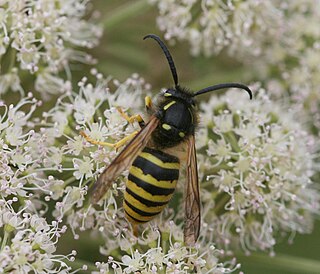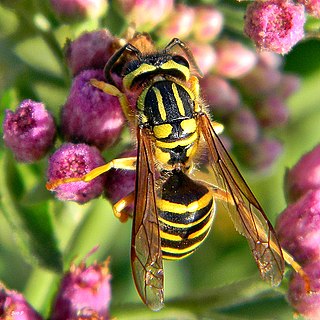
Hornets are the largest of the eusocial wasps, and are similar in appearance to yellowjackets, their close relatives. Some species can reach up to 5.5 cm (2.2 in) in length. They are distinguished from other vespine wasps by the relatively large top margin of the head. Worldwide, 22 species of Vespa are recognized. Most species only occur in the tropics of Asia, though the European hornet is widely distributed throughout Europe, Russia, North America, and north-eastern Asia. Wasps native to North America in the genus Dolichovespula are commonly referred to as hornets, but all of them are actually yellowjackets.

Sceliphron caementarium, also known as the yellow-legged mud-dauber wasp, black-and-yellow mud dauber, or black-waisted mud-dauber, is a species of sphecid wasp. There are some 30 other species of Sceliphron that occur throughout the world, though in appearance and habits they are quite similar to S. caementarium.

The Australian hornet, a type of potter wasp or "mason wasp", is a vespid native to the Australian states and territories of the Australian Capital Territory, New South Wales, Northern Territory, Victoria, Queensland and Western Australia. Despite its namesake, it is not a true hornet.

Mud dauber is a name commonly applied to a number of wasps from either the family Sphecidae or Crabronidae which build their nests from mud; this excludes members of the family Vespidae, which are instead referred to as "potter wasps". Mud daubers are variable in appearance. Most are long, slender wasps about 1 inch (25 mm) in length. The name refers to the nests that are made by the female wasps, which consist of mud molded into place by the wasp's mandibles. Mud daubers are not normally aggressive, but can become belligerent when threatened. Stings are uncommon.

The median wasp is a species of social wasp of the family Vespidae found throughout Europe and Asia. It builds aerial paper nests often in shrubs or trees, and occasionally under the eaves of buildings. It is most common to see this wasp between May and October during its 3.3 month colony cycle. Behaviours of this wasp include nest defense, curling which is believed to function in brood incubation, and gastral vibration which is involved in larval feeding. The median wasp has a halplodiploid sex determination system that results in a high level of relatedness within the colony. This species is not usually aggressive but will sting if they feel their nest is threatened. Most foraging in the nest is done by the workers once the first ones reach adulthood. These workers forage for insects, nectar, and wood for nest construction in temperatures as low as 7 °C (45 °F). The median wasp is known to be occasionally affected by the fungus Cordyceps sphecocephala and the Cricket paralysis virus.

Potter wasps, the Eumeninae, are a cosmopolitan wasp group presently considered a subfamily of Vespidae, but sometimes recognized in the past as a separate family, Eumenidae.

Abispa is a genus of large Australasian potter wasps belonging to the subfamily Eumeninae. The genus was first described in 1838 by Thomas Livingstone Mitchell.

The Stenogastrinae are a subfamily of social wasps included in the family Vespidae. They are sometimes called hover wasps owing to the particular hovering flight of some species. Their morphology and biology present interesting peculiarities.

A wasp is any insect of the narrow-waisted suborder Apocrita of the order Hymenoptera which is neither a bee nor an ant; this excludes the broad-waisted sawflies (Symphyta), which look somewhat like wasps, but are in a separate suborder. The wasps do not constitute a clade, a complete natural group with a single ancestor, as bees and ants are deeply nested within the wasps, having evolved from wasp ancestors. Wasps that are members of the clade Aculeata can sting their prey.

The tree wasp is a species of eusocial wasp in the family Vespidae, found in the temperate regions of Eurasia, particularly in western Europe. Despite being called the tree wasp, it builds both aerial and underground paper nests, and can be found in rural and urban habitats. D. sylvestris is a medium-sized wasp that has yellow and black stripes and a black dot in the center of its clypeus. It is most common to see this wasp between May and September during its 3.5 month colony cycle.

Dolichovespula adulterina is a species of parasitic social wasp found in the Palearctic region. D. adulterina feeds on a variety of foods, including insects, spiders, arthropods, meat, molluscs, fruit, nectar, and larval secretions. D. adulterina was formerly considered to be synonymous with D. arctica from the Holarctic region, but more recent research indicates that D. arctica is a separate species.

Vespula squamosa, or the southern yellowjacket, is a social wasp. This species can be identified by its distinctive black and yellow patterning and orange queen. This species is typically found in eastern North America, and its territory extends as far south as Central America. Within these territories, they create enormous, multiple-comb nests. The colonies may be either annual or perennial depending on the climate, and in many perennial nests, polygyny takes place. In addition, this species uses pheromones both as a sexual attractant and an alarm signal. This species feeds on insects and animal carcasses; it does not produce honey. V. squamosa, a social insect, has developed a parasitic relationship with the species V. vidua and V. maculifrons. Due to their painful, venomous stings, the species is considered a pest.

Polistes carnifex, commonly known as the executioner wasp or executioner paper wasp, is a neotropical vespid wasp in the cosmopolitan genus Polistes.
Apoica flavissima is a paper wasp found primarily in South America. The species is distinguishable by its light coloring, unique single comb nests, and nocturnal nature. A notable feature of this species is the size dimorphism between queens and workers. Unlike most Vespidae wasps, Apocia flavissima queens are smaller than their worker counterparts which results in unique intraspecies relationships.

Agelaia pallipes is a species of social paper wasp found from Costa Rica to Brazil, Argentina and Paraguay. A. pallipes is ground-nesting and is one of the most aggressive wasps in South America. This species is a predator of other insects, including flies, moths, and ground crickets, as well as baby birds.

Delta dimidiatipenne is a species of large, red-coloured potter wasp in the genus Delta that exists in the warmer regions of the Palearctic. Like many other potter wasps, it is a provisioning species that hunts caterpillars.

Polistes bischoffi is a species of paper wasps belonging to the family Vespidae.

Symmorphus allobrogus is a species of potter wasps belonging to the subfamily Eumeninae.

Vespa affinis, the lesser banded hornet, is a common hornet in tropical and subtropical Asia.

Symmorphus cristatus is a species of mason wasp in the subfamily Eumeninae within the family Vespidae. This species is widely distributed in North America, and it preys on the larvae of leaf beetles.



















